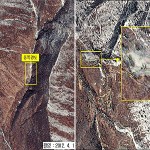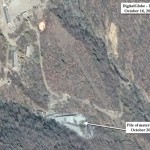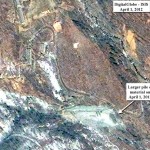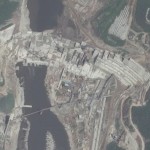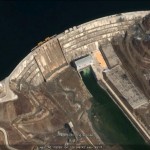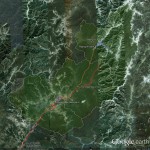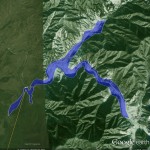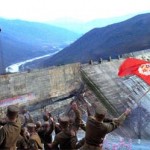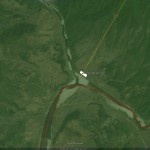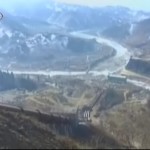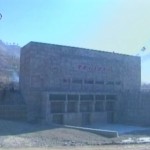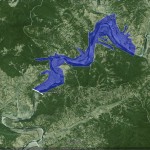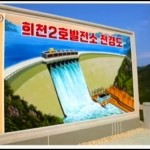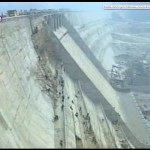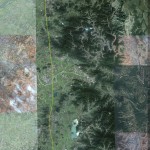UPDATE 7 (2012-4-18): The IAEA now states that it is not likely to send an inspection team to the DPRK. According to the Voice of America:
The International Atomic Energy Agency says it is now unlikely to send a delegation to North Korea, after Pyongyang stated it is no longer bound by an agreement with the United States not to test missiles and nuclear devices.
Spokeswoman Gill Tudor made the announcement late Tuesday, ending hopes for the visit for which IAEA officials began negotiating with North Korea in March.
Earlier in the day, Pyongyang said it was breaking off a bilateral agreement to halt its nuclear activities and allow IAEA inspectors to enter the country after the U.S. suspended much needed food aid. Washington said North Korea did not keep its end of the bargain when it carried out its failed missile launch on Friday.
North Korea’s Foreign Ministry vowed to continue trying to fire a long-range rocket into space to place what it said was a weather satellite into orbit. It also vowed unspecified retaliation now that the agreement with the U.S. is no longer in place.
State Department spokesperson Mark Toner said Tuesday that Pyongyang’s statement was “not surprising, given their recent behavior.” He said he could not predict whether North Korea is laying the ground work for a future nuclear test, as some fear.
UPDATE 6 (2012-4-17): North Korea announced that it has scrapped the “Leap day deal“. According to KCNA (2012-4-17):
Thirdly, as the U.S. violated the Feb. 29 DPRK-U.S. agreement through its undisguised hostile acts, we will no longer be bound to it.
UPDATE 5 (2012-4-17): Following the launch of the Unha-3 rocket in April of 2012, the US has scrapped the “Leap Day Deal” to provide food aid for a suspension of the DPRK’s nuclear program. According to the Los Angeles Times:
The Obama administration announced shortly after the launch Friday that it was scrapping a Feb. 29 agreement to send 240,000 metric tons of food to North Korea, a promise made as inducement for Pyongyang to abide by previous U.N. resolutions and suspend its nuclear programs.
UPDATE 4 (2012-3-31): The DPRK attacks the US decision to suspend food assistance. According to Bloomberg:
North Korea criticized a U.S. announcement that it would suspend food aid if the Asian country carries out a planned “peaceful” satellite launch, calling it an overreaction “beyond the limit.”
Suspending food aid “would be a regrettable act” scrapping the entire Feb. 29 agreement between the two nations, North Korea’s state-run Korean Central News Agency said, quoting a foreign ministry spokesman it didn’t name.
North Korea drew rebukes from nations including the U.S. earlier this month when it revealed plans to launch an “earth observation satellite” in April to mark the 100th anniversary of the birth of state founder Kim Il Sung.
U.S. President Barack Obama, who visited Seoul for a Nuclear Security Summit this week, warned North Korea that its plan to fire a long-range rocket undermined prospects for future negotiations, while South Korea’s military said Kim Jong Un’s forces had moved the missile to a launch site.
North Korea’s announcement of a mid-April launch will make it difficult to move forward with the aid deal and broader efforts to get the regime back to negotiations on its nuclear weapons program, Obama said.
UPDATE 3 (2012-3-28): Food aid deal will be suspended if DPRK goes through with April rocket launch. According to the American Forces Press Service:
Concerns that North Korea would resume provocative behavior on the international stage in 2012 have proven true, so the United States has suspended plans to provide nutrition aid to the impoverished nation, senior defense officials told Congress today.
“Our suspicions … were confirmed when North Korea announced on March 16 that it plans to conduct a missile launch between April 12th and 16,” Peter R. Lavoy, acting assistant secretary of defense for Asian and Pacific security affairs, told members of the House Armed Services Committee. “This grand launch is highly provocative, because it manifests North Korea’s desire to test and expand its long-range missile capability.”
Army Gen. James D. Thurman, commander of U.S. Forces Korea, testified alongside Lavoy in a hearing examining the security situation on the Korean Peninsula.
After a series of U.S.-North Korean discussions in late February, the North Korean government agreed to implement a moratorium on long-range missile launches — then announced plans for the launch just two weeks later, Lavoy explained.
The United States had agreed during the February talks to provide nutritional aid to North Korea. The World Food Program in November 2011 recommended targeted high-nutrition aid as critical to 3 million North Koreans most at risk for starvation.
Lavoy and Thurman both confirmed the United States will not deliver the planned nutrition aid.
“During those discussions, the United States made it very clear that a satellite launch would be a deal-breaker,” Lavoy told the panel.
Both men said U.S. officials have worked to “delink” humanitarian aid and political concerns, but defended the decision to suspend nutritional aid.
“The fact that North Korea so brazenly violated commitments that it just so recently agreed to … indicates that they’re not reliable,” Lavoy said. “We cannot expect them to meet … the commitments that they’ve agreed to that are associated with the provision of nutritional assistance to the needy population in their country.
“It’s regrettable that the food aid is not moving forward,” he added. “The North Korean population really needs nutritional assistance. And we’re prepared to provide that to North Korea.”
Thurman said officials are working closely with allies and other partners in the region to try to discourage North Korea from launching the missile. Meanwhile, the general added, “we have been forced to suspend our activities to provide nutritional assistance to North Korea.”
Lavoy said the threatened launch would be in direct violation of U.N. Security Council resolutions 1718 and 1874, which prohibit North Korea from conducting any launches that use ballistic missile technology.
The launch would involve a North Korean-made Kwangmyongsong-3 polar-orbiting Earth observation satellite to mark the 100th birthday of late President Kim Il Sung, a spokesman for the Korean Committee for Space Technology said in a statement.
The late president’s birthday is April 15.
Lavoy said North Korea’s authoritarian government, founded by Kim Il Sung and subsequently led by Kim Jong Il and Kim Jong Un — his son and grandson, respectively — seeks to provoke other nations militarily as a means of demonstrating power to its people.
“Political successions are extraordinarily difficult when you don’t have a representative government, which is the case there, of course,” he noted. Kim Jong Un took power after his father’s death in December.
“What we’re seeing now and what we anticipate is provocative behavior, because, unfortunately, this seems to be the only way that the North Korean regime can try to demonstrate its bona fides to a population that is suffering terribly,” Lavoy added.
Thurman said North Korea’s “military first” policy diverts national resources away from food and essential services to the people.
“They maintain the fourth-largest conventional military force in the world, the world’s largest special operating force, and significant long-range artillery capabilities,” the general said. “Over 70 percent of their combat powers are arrayed within 90 miles of the demilitarized zone.”
South Korea, home to some 28,500 forward-based U.S. troops, is “a vibrant democracy, economic success and global security partner, currently serving beside us in Afghanistan and off the Horn of Africa,” Thurman said.
“In stark contrast, one of the world’s poorest, most closed and
most militarized countries, North Korea, lies less than 20 miles from the northern districts of Seoul, a city of over 24 million people,” he added.
The United States and South Korea have for 60 years maintained a close partnership aimed at deterring North Korean aggression and maintaining stability on the peninsula, Thurman noted.
“We are prepared to defend the peninsula and can do that,” the general said. “And we can repel any type of attack should the North Koreans decide to do that.”
UPDATE 2 (2012-3-23): North Korea has announced it will conduct another “Satellite” Launch (aka ICBM test). Jeffrey Lewis writes about the unwinding of the “Leap-day deal” at Arms Control Wonk.
UPDATE 1 (2012-3-15): The Choson Ilbo reports that the DPRK has agreed to allow more monitoring of food aid distribution:
The North apparently agreed during the latest meeting with U.S. officials in Beijing to increase the number of monitors to 70. Their task will be to check that the food reaches civilians who need it and is not diverted to the military. A diplomatic source in Seoul said the U.S. has decided to send monitors who are fluent in Korean to the North when it takes delivery of 20,000 tons of food aid per month over a year, as agreed.
Robert King, the U.S. special envoy for North Korean human rights, met on March 7 and 8 with An Myong-hun of the North Korean Foreign Ministry and agreed the terms, the source said.
North Korea accepted most U.S. demands, the source added. Washington apparently insisted that Pyongyang must accept U.S. requests to dispatch monitors to a particular regions at 24 hours’ notice.
After the talks, King said he was “very satisfied” with the results. The U.S. will brief the World Food Programme in Rome on the outcome on Thursday. The WFP then handles the provision of food aid along with five other aid groups based in the U.S. The aid, which takes the form of nutritional supplements rather than rice, will go to North Korean children between the ages of five and seven as well as pregnant women.
ORIGINAL POST (2012-2-29): According to the Associated Press (Via Washingotn Post):
The United States says North Korea has agreed to suspend uranium enrichment and agree to a moratorium on nuclear and long-range missile tests.
State Department spokeswoman Victoria Nuland also said Wednesday the North has agreed to allow International Atomic Energy Inspectors to verify and monitor the moratorium on uranium enrichment and confirm disablement of its nuclear reactor at Yongbyon.
Her statement says the U.S. will meet with North Korea to finalize details for a proposed package of 240,000 metric tons of food aid.
The Washington Post provides additional information:
The agreement is the result of talks between U.S. and North Korean negotiators late last week in Beijing — the first such negotiations since the death of North Korean leader Kim Jong Il and the elevation of his son Kim Jong Eun.
…
While U.S. leaders have insisted that the food aid for the impoverished country and nuclear disarmament are separate issues, North Korean officials have tied the two in past negotiation
Here is the official statement by the State Department:
U.S.-DPRK Bilateral Discussions
Press Statement
Victoria Nuland
Department Spokesperson, Office of the Spokesperson
Washington, DC
February 29, 2012
A U.S. delegation has just returned from Beijing following a third exploratory round of U.S.-DPRK bilateral talks. To improve the atmosphere for dialogue and demonstrate its commitment to denuclearization, the DPRK has agreed to implement a moratorium on long-range missile launches, nuclear tests and nuclear activities at Yongbyon, including uranium enrichment activities. The DPRK has also agreed to the return of IAEA inspectors to verify and monitor the moratorium on uranium enrichment activities at Yongbyon and confirm the disablement of the 5-MW reactor and associated facilities.
The United States still has profound concerns regarding North Korean behavior across a wide range of areas, but today’s announcement reflects important, if limited, progress in addressing some of these. We have agreed to meet with the DPRK to finalize administrative details necessary to move forward with our proposed package of 240,000 metric tons of nutritional assistance along with the intensive monitoring required for the delivery of such assistance.
The following points flow from the February 23-24 discussions in Beijing:
The United States reaffirms that it does not have hostile intent toward the DPRK and is prepared to take steps to improve our bilateral relationship in the spirit of mutual respect for sovereignty and equality.
The United States reaffirms its commitment to the September 19, 2005 Joint Statement.
The United States recognizes the 1953 Armistice Agreement as the cornerstone of peace and stability on the Korean Peninsula.
U.S. and DPRK nutritional assistance teams will meet in the immediate future to finalize administrative details on a targeted U.S. program consisting of an initial 240,000 metric tons of nutritional assistance with the prospect of additional assistance based on continued need.
The United States is prepared to take steps to increase people-to-people exchanges, including in the areas of culture, education, and sports.
U.S. sanctions against the DPRK are not targeted against the livelihood of the DPRK people.
Here is the statement in KCNA:
DPRK Foreign Ministry Spokesman on Result of DPRK-U.S. Talks
Pyongyang, February 29 (KCNA) — The spokesman of the Ministry of Foreign Affairs of the Democratic People’s Republic of Korea on Wednesday gave the following answer as regards questions raised by KCNA concerning the result of the latest DPRK-U.S. high-level talks:
Delegations of the Democratic People’s Republic of Korea (DPRK) and the United States of America (U.S.) met in Beijing, China on 23rd and 24th of February for the third round of the high-level talks between the DPRK and the U.S.
Present at the talks were the delegation of the DPRK headed by Kim Kye Gwan, the First Vice Minister of Foreign Affairs, and the delegation of the U.S. headed by Glyn Davies, the Special Representative of the State Department for the DPRK Policy.
The talks, continuation of the two previous DPRK-U.S. high-level talks held respectively in July and October, 2011, offered a venue for sincere and in-depth discussion of issues concerning the measures aimed at building confidence for the improvement of relations between the DPRK and the U.S. as well as issues related with ensuring peace and stability on the Korean Peninsula and resumption of the six-party talks.
Both the DPRK and the U.S. reaffirmed their commitments to the September 19 Joint Statement and recognized that the 1953 Armistice Agreement is the cornerstone of peace and stability on the Korean Peninsula until the conclusion of a peace treaty.
Both the DPRK and the U.S. agreed to make a number of simultaneous moves aimed at building confidence as part of the efforts to improve the relations between the DPRK and the U.S.
The U.S. reaffirmed that it no longer has hostile intent toward the DPRK and that it is prepared to take steps to improve the bilateral relations in the spirit of mutual respect for sovereignty and equality.
The U.S. also agreed to take steps to increase people-to-people exchanges, including in the areas of culture, education, and sports.
The U.S. promised to offer 240,000 metric tons of nutritional assistance with the prospect of additional food assistance, for which both the DPRK and the U.S. would finalize the administrative details in the immediate future.
The U.S. made it clear that sanctions against the DPRK are not targeting the civilian sector, including the livelihood of people.
Once the six-party talks are resumed, priority will be given to the discussion of issues concerning the lifting of sanctions on the DPRK and provision of light water reactors.
Both the DPRK and the U.S. affirmed that it is in mutual interest to ensure peace and stability on the Korean Peninsula, improve the relations between the DPRK and the U.S., and push ahead with the denuclearization through dialogue and negotiations.
Both sides agreed to continue the talks.
The DPRK, upon request by the U.S. and with a view to maintaining positive atmosphere for the DPRK-U.S. high-level talks, agreed to a moratorium on nuclear tests, long-range missile launches, and uranium enrichment activity at Nyongbyon and allow the IAEA to monitor the moratorium on uranium enrichment while productive dialogues continue.
Evan Ramstad analyses the differences be3tween the DPRK and US State Department statements in this Wall Street Journal article.
The New York Times offers some caveats:
North Korea has agreed in the past to halt its nuclear program only to back out, demanding more concessions or accusing the United States of reneging on its obligations. And the statement Tuesday from the North’s official Korean Central News Agency appeared to give the country’s leaders wiggle room again this time, saying that Pyongyang would carry out the agreement “as long as talks proceed fruitfully.”
Still, North Korea’s agreement to allow inspectors from the International Atomic Energy Agency to return to the country appeared to be a significant concession. After years of negotiations, North Korea expelled inspectors and went on to test nuclear devices in 2006 and 2009. American intelligence officials believe the country has enough fuel already for six to eight weapons.
If the North lives up to its agreement to stop uranium enrichment, it could help ease some anxieties in Washington over the program at a time when the administration, in an election year, is consumed with halting Iran’s nuclear program before Israel decides to stage an attack.
For the relatively young and inexperienced Mr. Kim, the agreement could be crucial to solidifying his hold on power and the backing of the powerful military, analysts in South Korea said. He needs to show in the early months of his rule that he is improving people’s lives after years of food shortages and a devastating famine. Bringing in 240,000 metric tons of food aid from the United States will surely help.
CNN reports (sorry, no link) that the details of this agreement were largely negotiated before Kim Jong-il passed away.
Additional Information:
1. Here are Scott Snyder’s thoughts on the agreement. Here are Joel Wit’s comments. Here are Gordon Flake’s.
2. Here is coverage in the Wall Street Journal, Los Angeles Times, The Guardian, and Stratfor.
3. Joshua Stanton (OFK) posted a transcript of the entire State Department briefing. Here is the State Department Briefing transcript from State.
4. I have kept a collection of significant news and satellite imagery of the DPRK’s nuclear facilities. You can see the information here.
5. The DPRK lobbied very hard for food aid from the international community throughout 2011.
6. Here is a list of US – DPRK engagement in 2011. Fox News also reports that an American ship has arrived in North Korea to assist in the search for the remains of Korean War MIAs.
7. More on the talks that preceded the announcement of the deal here
Read the full stories here:
U.S. says N. Korea has agreed to suspend uranium enrichment, moratorium on nuclear, missile tests
Associated Press (Via Washingotn Post)
2012-2-29
N. Korea agrees to suspend uranium enrichment, nuclear tests
Washington Post
William Wan
2012-2-29
